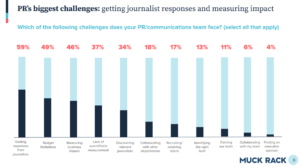Muck Rack recently released their 2021 State of Public Relations Report, assessing how PR teams establish media relations, measure campaign success, and use technology. This year, over 1,618 communications professionals were surveyed between April and May, representing a variety of communications industries, company types, team sizes, and focuses. The survey also gave voice to a variety of company roles, interviewing interns to CEOs.
In their 2021 Report, Muck Rack aimed to tackle these important questions:
- What are the top challenges PR pros face?
- What tech and tools do PR teams use to do their jobs?
- How do PR pros try to reach journalists?
- How do PR pros use social media?
- How are PR budgets changing and how are teams allocating them?
- How are PR teams measuring success?
- What is the future of PR?
In this blog, we’ll give an overview of the main insights and statistics you’ll want to know as a PR professional. For the full details and survey results, download Muck Rack’s State of PR Report through their website.
What are the top challenges PR pros face?
PR pros cited “getting responses from journalists” (59%) as their top challenge. This was especially true for agencies, with 65% of agency pros citing this as their top issue. Trailing not so far behind, “budget limitations” (49%) and “measuring business impact” (46%) appeared as the second and third most popular responses. “Budget Limitations” was the top response for practitioners working in the nonprofit sector.
Understanding the challenges they faced also helped PR pros reflect on how they could increase value within their organizations. Agency PR pros remarked that the best way for them to increase value was by increasing coverage and/or media relationships for their brands. Nonprofits and in-house PR practitioners said that improving internal communications and defining the role of PR within their company would add the most value.

What tech and tools do PR teams use to do their jobs?
As expected, PR teams are still choosing a few general tools to use daily:
- Email (100%)
- Documents (96%)
- Spreadsheets (78%)
Only about half of professionals surveyed access news monitoring and media databases on a daily basis, though PR pros working at agencies reported using them more (57%). Project management software was not found to be popular, with only about 31% of PR teams using it daily. Team communication is more often taking place through email (100%), video conferencing (82%), and direct messaging (81%), than project management software.
How do PR pros try to reach journalists?
42% of PR pros agreed that relevance was the most important component of a pitch for potential reporters. This was followed by how personalized the pitch was to the reporter (35%), and how timely the pitch was (14%). Interestingly enough, according to Muck Rack’s State of Journalism 2021 report, lack of timeliness was the number one reason reporters rejected relevant pitches. 96% of PR pros found 1:1 emails to be the most effective means of pitching a reporter, with mass email and phone calls trailing far behind around 20%.
Most PR pros are pitching an average of four types of media, according to the report. The main media types they’re pitching are online/digital (95%), newspapers (78%) and magazines (70%), also noting that there is a lot of room for pitches in the newsletter and podcast media space.
In terms of when to pitch, late mornings (9 a.m. – 12 p.m.) on Tuesdays were identified as the ideal time. This finding is inconsistent with journalists’ favored pitch time, which is early morning on Mondays, according to the State of Journalism. This same contradiction comes up with the length of PR pitches. 50% of pros are writing pitches between 100 and 200 words, while 1 in 4 journalists state that they prefer pitches under 100 words. Luckily, reporters and PR pros align when it comes to follow-ups. Most surveyed pros (49%) said 1 follow-up is acceptable, and 90% of journalists agree.

How do PR pros use social media?
The most used social media site, LinkedIn, comes in first (57%), with Instagram and Twitter following behind (43%). Agency pros report being a bit more enthusiastic about new platforms like TikTok and Clubhouse over their in-house and non-profit counterparts. 81% of respondents saw LinkedIn as most important to their company’s social strategies, with Twitter (77%), and Instagram (65%) following. Once again, agency pros appear to put more emphasis on newer social media platforms, 17% naming Clubhouse as one of their most important platforms, while only 7% of other pros named the new chat room app.
How are PR budgets changing and how are teams allocating them?
The good news for PR teams is that 95% of people surveyed expect budgets for PR to remain the same (50%) or increase (45%). Agency pros were more likely to say their budget was increasing than staying the same. When it comes to who’s deciding on PR spend, 34% of respondents said the budget was decided by the CEO, 31% said the top communicator and 22% said the top marketer. And where is most of the budget going? 24% of respondents pointed to media databases as their biggest PR spend (aside from employees), followed by agencies (21%) and contractors/freelancers (17%).
How are PR teams measuring success?
Most PR pros are sticking to the basics when it comes to showing stakeholders the success of their communications strategies. 97% of pros said they used “traditional metrics” to prove the success of their communications efforts. 78% pointed to social media impact as their evidence, and 66% looked at website impact. Both of these metrics (social media and website) have seen significant growth since 2020, where social metrics sat at 69% and website metrics at 52%. Internally, the responses remained pretty much the same. Traditional metrics (81%), social media impact (72%) and website impact (52%) came out on top. And how many goals are PR pros tending to? Most pros (32%) said they were responsible for 3 KPI’s (Key Performance Indicators), while others ranged between 6+ (18%) and 2 (17%).

What is the future of PR?
Industry professionals predict PR will continue to be on the frontlines of change and innovation. Most practitioners anticipate moderate (48%) to drastic change (34%) in the next 5 years. Luckily, 69% of PR pros also reported feeling “somewhat” prepared for the changes ahead, with 21% feeling “very prepared”. But what will “public relations” even mean in 5 years? 73% of PR pros believe the term will need to be redefined within the next 5 years to account for continuous change. This redefined industry won’t be any less significant though, with 83% of practitioners reporting that the importance of PR/communications pros will only grow.
Whew! That’s a lot to take in. Are you surprised by the results? Reassured? Let us know your thoughts on our changing PR industry by leaving a comment or tweeting us @BIGfishPR.


